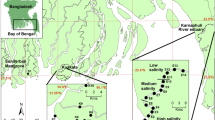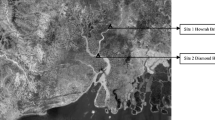Abstract
Vibrios are bacteria of marine and estuarine origin that can cause human diseases, such as cholera, and also affect aquatic organisms. The impact of storm-driven changes in salinity and suspended particulate matter (SPM) on cultivable Vibrio counts (CVC) and distribution in Karnaphuli estuary, Bangladesh, was compared before and after a strong cyclone in mid May 2007 and after a monsoon landslide a month later. CVC were higher (~103 colony forming units—cfu/ml) at estuary’s mouth (salinity 20–15 parts per thousand, ppt) and steeply declined landwards. CVC and their proportion of total aerobic bacteria were highest after the cyclone and also increased after the landslide, likely due to higher SPM loads. The cyclone did not significantly change previous fecal coliform abundance, contrasting with the ten times increase after the landslide. Sewage input enhanced CVC near the point sources. CVC and salinity correlated highly significantly at salinities <10 ppt; however, at higher values dispersion increased, probably due to the effect of sediment resuspension on CVC. Cyclone or heavy rainfall-mediated turbidity changes jointly with salinity gradients can significantly influence abundance and distribution of estuarine vibrios. Extended salt intrusion and higher turbidities in tropical estuaries by stronger and more frequent storms and deforestation-derived erosion could favor Vibrio growth, with increasing risks for aquatic resources and human health in the coastal zone.





Similar content being viewed by others
References
Alam M, Mainuddin K, Rahman A, Uzzaman R (2007) Governance Screening for Urban Climate Change Resilience-building and Adaptation Strategies in Asia: Assessment of Chittagong City, Bangladesh. Report of the Bangladesh Centre for Advanced Studies (BCAS). Institute of Development Studies, University of Sussex, 15 pp
Alm EW, Burke J, Hagan E (2006) Persistence and potential growth of the fecal indicator bacteria, Escherichia coli, in shoreline sand at Lake Huron. Journal of Great Lakes Research 32:401–405
Anonymous (2007a) Cyclone Akash. http://en.wikipedia.org/wiki/Cyclone_Akash. Accessed 3 Dec 2007
Anonymous (2007b) Chittagong Mudslides. http://en.wikipedia.org/wiki/2007_ Chittagong-mudslide. Accessed 3 Dec 2007
Anonymous (2007c) Improving Policy-Livelihood Relationships in South Asia: Water Resources and Sanitation Programme. Stockholm Environment Studies. http://www.york.ac.uk/inst/sei/prp/about.html. Accessed 16 Feb 2009
APHA (2005) Standard Methods for the Examination of Water and Wastewater, 21st ed., Washington, DC: American Public Health Association (APHA), American Water Works Association (AWWA) & Water Environment Federation (WEF)
Chakraborty S, Nair GB, Shinoda S (1997) Pathogenic vibrios in the natural aquatic environment. Reviews on Environmental Health 12:63-80
Chigbu P, Gordon S, Strange T (2004) Influence of inter-annual variations in climatic factors on fecal coliform levels in Mississippi Sound. Water Research 38:4341-4352
Colwell RR (1996) Global climate and infectious disease: the cholera paradigm. Science 274:2025-2032
Drasar BS, Forrest BD (1996) Cholera and the ecology of Vibrio cholerae. London: Chapman and Hall
Fries JS, Characklis GW, Noble RT (2008) Sediment-water exchange of Vibrio spp. and fecal indicator bacteria: Implications for persistence and transport in the Neuse River Estuary, North Carolina, USA. Water Research 42:941-950
Hansen HP, Grasshoff K (1983) Automated chemical analysis. In: Methods of Seawater Analysis, Grasshoff K, Ehrhardt M, Kremling K (editors), Verlag Chemie, Weinheim, pp. 347–377
Hespanhol I (1997) Wastewater as a Resource. In: Water pollution control: a guide to the use of water quality management principles, Chapter 4. Helmer R, Hespanhol, I (editors), WHO/UNEP. E. and F. Spon Ltd., London
IPCC (2007) An Assessment of the Intergovernmental Panel on Climate Change: Synthesis Report Summary for Policymakers. http://www.ipcc.ch/pdf/assessment-report/ar4/syr/ar4_syr_spm.pdf. Accessed 24 Aug 2008, 22 pp
Islam MS, Alam MJ, Khan SI, Huq A (1994a) Fecal pollution of freshwater environments in Bangladesh. International Journal of Environmental Studies 46:161-165
Islam MS, Drasar BS, Sack RB (1994b) Probable role of blue-green algae in maintaining endemicity and seasonality of cholera in Bangladesh: a hypothesis. Journal of Diarrhoeal Diseases Research 12:245-256
Islam MS, Siddika A, Khan MNH, Goldar MM, Sadique MA, Kabir ANMH, et al. (2001) Microbiological analysis of tube-well water in a rural area of Bangladesh. Applied and Environmental Microbiology 67:3328-3330
Islam MS, Brooks A, Kabir MS, Jahid IK, Shafiqul Islam M, Goswami D, et al. (2007) Fecal contamination of drinking water sources of Dhaka city during the 2004 flood in Bangladesh and use of disinfectants for water treatment. Journal of Applied Microbiology 103:80-87
Kattner G (1999) Storage of dissolved inorganic nutrients in seawater: poisoning with mercuric chloride. Marine Chemistry 67:61-66
Koh EG, Huyn JH, LaRock PA (1994) Pertinence of indicator organisms and sampling variables to Vibrio concentrations. Applied and Environmental Microbiology 60:3897-3900
Lee CM, Lin TY, Lin CC, Kohbodi GA, Bhattl A. Lee R, et al. (2006) Persistence of fecal indicator bacteria in Santa Monica Bay beach sediments. Water Research 40:2593-2602
Lipp EK, Huq A, Colwell RR (2002) Effects of global climate on infectious disease: the cholera model. Clinical Microbiology Reviews 15:757-770
Mallin MA, Cahoon LB, Toothman BR, Parsons, DC, McIver MR, Ortwine ML, et al. (2007) Impacts of a raw sewage spill on water and sediment quality in an urbanized estuary. Marine Pollution Bulletin 54:81-88
Miller CJ, Drasar BS, Feachem RG (1984) Response of toxigenic Vibrio cholerae O1 to physico-chemical stresses in aquatic environments. Journal of Hygiene Cambridge 93:475-495
OCHA (2007) Bangladesh Cyclone Sidr. United Nations Office for the Coordination of Humanitarian Affairs. http://ochaonline.un.org/News/Emergencies/Bangladesh/tabid/2707/Default.aspx. Accessed 3 Dec 2007
Polprasert C, Dissanayake MG, Thanh NC (2002) Bacterial die-off kinetics in stabilization ponds. http://www.cepis.org.pe/eswww/fulltext/repind57/bdk/bdk.html. Accessed 18 Feb 2009
Schwartz BS, Harris JB, Khan AI, Larocque RC, Sack DA, Malek MA, et al. (2006) Diarrhoeal epidemics in Dhaka, Bangladesh, during three consecutive floods: 1988, 1998, and 2004. American Journal of Tropical Medicine and Hygiene 74:1067-1073
Siddique AK, Baqui AH, Eusof A, Zaman K (1991) The 1988 floods in Bangladesh: pattern of illness and causes of death. Journal of Diarrhoeal Diseases Research 9:310-314
Singleton FL, Attwell R, Jangi S, Colwell RR (1982) Effects of temperature and salinity on Vibrio cholerae growth. Applied and Environmental Microbiology 44:1047-1058
Sinigalliano CD, Gidley ML, Shibata T, Whitman D, Dixon TH, Laws E, et al. (2007) Impacts of Hurricanes Katrina and Rita on the microbial landscape of the New Orleans area. Proceedings of the National Academy of Sciences of the United States of America 104:9029-9034
Thompson FL, Lida T, Swings J (2004) Biodiversity of vibrios. Microbiology and Molecular Biology Reviews 68:403-431
West PA, Colwell RR (1984) Identification and classification of Vibrionaceae: an overview. In: Vibrios in the Environment, Colwell RR (editor), New York: John Wiley & Sons, pp 285-363
Whitman RL, Nevers MB, Byappanahalli MN (2006) Examination of the watershed-wide distribution of Escherichia coli along southern Lake Michigan: an integrated approach. Applied and Environmental Microbiology 72:7301-7310
Williams LA, LaRock PA (1985) Temporal occurrence of Vibrio species and Aeromonas hydrophila in estuarine sediments. Applied and Environmental Microbiology 50:1490-1495
Wolanski E, Boorman LA, Chícharo L, Langlois-Saliou E, Lara RJ, Plater AJ, et al. (2004) Ecohydrology as a new tool for sustainable management of estuaries and coastal waters. Wetlands Ecology and Management 12:235-276
Acknowledgements
This work was funded by the grant LA 868/5-1 from DFG/BMZ, Germany. We thank the Environmental Microbiology Laboratory of ICDDR, B, specially Iqbal Zahid, Sumi Akter, Md. Motin, Md. Hafiz Uddin, Partho Gope, and Debashish Paul for their support during sample collection and processing, and Dieter Peterke (ZMT) for his technical assistance.
Author information
Authors and Affiliations
Corresponding author
Rights and permissions
About this article
Cite this article
Lara, R.J., Neogi, S.B., Islam, M.S. et al. Influence of Catastrophic Climatic Events and Human Waste on Vibrio Distribution in the Karnaphuli Estuary, Bangladesh. EcoHealth 6, 279–286 (2009). https://doi.org/10.1007/s10393-009-0257-6
Received:
Revised:
Accepted:
Published:
Issue Date:
DOI: https://doi.org/10.1007/s10393-009-0257-6




